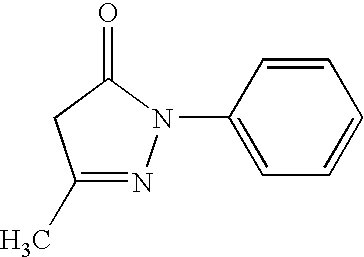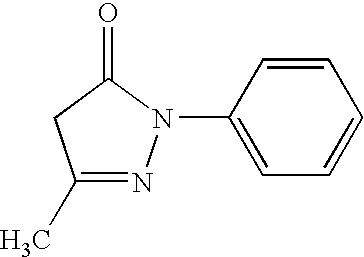Percutaneous absorption preparation containing 3-methyl-1-phenyl-2-pyrazolin-5-one
a technology of phenyl-2-pyrazolin and percutaneous absorption, which is applied in the direction of biocide, drug composition, cardiovascular disorder, etc., can solve the problems of poor cerebral ischemia damage, patient pain, and inability to administer injections by the patient himself/herself, so as to reduce the number of times the medication is administered, promote patient compliance, and reduce the effect of medication concentration
- Summary
- Abstract
- Description
- Claims
- Application Information
AI Technical Summary
Benefits of technology
Problems solved by technology
Method used
Image
Examples
example 1
[0059] Liquid A was adjusted by mixing 5 parts sodium polyacrylate, 6 parts starch acrylate, 12 parts talc, and 29.1 parts concentrated glycerin. Liquid B was adjusted by dissolving 2.3 parts tartaric acid in 30 parts water. Liquid C was adjusted by dissolving 3 parts 3-methyl-1-phenyl-2-pyrazolin-5-one in 8 parts n-methyl-2-pyrrolidone and 2 parts crotamiton. Liquid B and liquid C were added to liquid A. Also, 2.5 parts methyl acrylate / acrylic acid 2-ethylhexyl copolymer resin emulsion and 0.1 parts aluminum hydroxide gel were added and mixed evenly. A base layer was then formed by spreading this mixture (this preparation) at a predetermined thickness on a polyester non-woven fabric (support medium) of predetermined dimensions (length dimensions×width dimensions×thickness; the same applies hereafter). This base layer was then covered with a polyethylene film (liner) of predetermined dimensions. This was then cut into predetermined dimensions to obtain a percutaneous absorption adhe...
example 2
[0060] 20 parts polybutene, 10 parts polyisobutylene, 25 parts styrene-isobutylene-styrene block copolymer, 0.5 parts di-butylhydroxytoluene, 14.5 parts liquid paraffin, 10 parts water absorbing-polymer [starch acrylate 1000 (proprietary name: Sunwet IM 1000)], 17 parts adhesive (proprietary name: Alcon P-100), and 3 parts 3-methyl-1-phenyl-2-pyrazolin-5-one were dissolved in 60 parts isohexane. Then, a base layer was formed by spreading this solution (the preparation) at a predetermined thickness on a polyvinyl chloride sheet (support member) of predetermined dimensions. This was then dried and the solvent removed, after which the base layer was covered with a polyester film (liner). This was then cut into predetermined dimensions to obtain a percutaneous absorption adhesive preparation containing 3-methyl-1-phenyl-2-pyrazolin-5-one of Example 2.
example 3
[0061] Liquid A was adjusted by mixing, at 140 degrees Celsius, 20 parts polybutene, 10 parts polyisobutylene, 19.5 parts liquid paraffin, 25 parts styrene-isobutylene-styrene block copolymer, 0.5 parts di-butylhydroxytoluene, and 17 parts adhesive (proprietary name: Alcon P-100). Liquid B was adjusted by evenly mixing 3 parts 3-methyl-1-phenyl-2-pyrazolin-5-one into 5 parts propylene glycol. After heating liquid A from room temperature to 120 degrees Celsius, liquid B was then added to, and mixed with, liquid A. A base layer was then formed by spreading this mixture (this preparation) at a predetermined thickness on a polyester non-woven fabric of predetermined dimensions. This base layer was then covered with a polyethylene film (liner) of predetermined dimensions. After being cooled to room temperature, this was then cut into predetermined dimensions to obtain a percutaneous absorption adhesive preparation containing 3-methyl-1-phenyl-2-pyrazolin-5-one of Example 3.
[0062] Test E...
PUM
| Property | Measurement | Unit |
|---|---|---|
| temperature | aaaaa | aaaaa |
| diameter | aaaaa | aaaaa |
| constant temperature | aaaaa | aaaaa |
Abstract
Description
Claims
Application Information
 Login to View More
Login to View More - R&D
- Intellectual Property
- Life Sciences
- Materials
- Tech Scout
- Unparalleled Data Quality
- Higher Quality Content
- 60% Fewer Hallucinations
Browse by: Latest US Patents, China's latest patents, Technical Efficacy Thesaurus, Application Domain, Technology Topic, Popular Technical Reports.
© 2025 PatSnap. All rights reserved.Legal|Privacy policy|Modern Slavery Act Transparency Statement|Sitemap|About US| Contact US: help@patsnap.com



